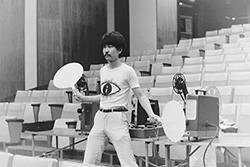
Throwing Shadows: Japanese Expanded Cinema in the Time of Pop
22 - 24 January 2016, London
 Throwing Shadows: Japanese Expanded Cinema in the Time of Pop
Throwing Shadows: Japanese Expanded Cinema in the Time of Pop
Tate Modern
Friday 22 January – Sunday 24 January 2016
£5, concessions available per screening
Throwing Shadows celebrates remarkable and little seen works by Japanese artists who worked with film, performance and projection in the age of pop. Organised in dialogue with The EY Exhibition: The World Goes Pop, the season showcases film works related to pop by artists featured in the exhibition including Keiichi Tanaami and Toshio Matsumoto as well as the first solo presentations in Europe of the films and performances of Jun’ichi Okuyama and Rikuro Miyai.
The title Throwing Shadows is a literal translation of the two kanji characters that constitute the word projection (toei), which came into popular usage in the 1960s to emphasise film’s propensity for action that could break cinema out of its assumed stasis. By the time ‘expanded cinema’ was introduced as a term in Japan the mid-1960s largely for multi-projection film works, alternative approaches to moving image were also being explored in response to the changing media landscape and emergence of new technologies that proposed the concept of ‘intermedia.’ In the riveting time of pop, Japanese expanded cinema staged a playful collision between light and shadow for visual and aural stimulation.
Curated by Go Hirasawa, Julian Ross and George Clark.
Throwing Shadows: Japanese Expanded Cinema in the Time of Pop is a collaboration between Tate Modern and International Film Festival Rotterdam.
Presented in partnership with the Japan Foundation
Eyes Go Pop: Psychedelic Japan
Tate Modern, Joiner Galleries, Level 4
Friday 22 January 2016, 19.00 – 21.00
These psychedelic works from the atomic age explore the artistic possibilities of printed media and mass-production to alter minds. Including the UK premiere of Phenomenology of Zeitgeist a double projection film by Rikuro Miyai that documents unauthorised actions on the streets of the Shinjuku district of Tokyo by the radical performance group Zero-Jigen. The evening will also feature Mako Idemitsu’s film Inner Man on gender and cultural collision, Tatsuo Shimamura psychedelic city film Illusion City and Keiichi Tanaami’s virtuoso animations and rare multi projection film 4 Eyes.
Rikuro Miyai will present Phenomenology of Zeitgeist in person with live music by lll人 (Paul Abbott / Seymour Wright / Daichi Yoshikawa)
Keiichi Tanaami 4 Eyes Japan 1975, 16mm, multiple projection, colour, 9 min
Mako Idemitsu Inner Man USA/Japan 1972, 16mm transferred to video, colour, 4 min
Keiichi Tanaami Sweet Touch of Love, Japan 1974, 16mm, colour, 3 min
Tatsuo Shimamura Illusion City / 幻影都市 Japan 1967, 16mm transferred to video, colour, 4 min
Keiichi Tanaami Why Japan 1975, 16mm, b&w and colour, 10 min
Rikuro Miyai Phenomenology of Zeitgeist / 時代精神の現象学 Japan 1968, 16mm, multiple projection, b&w, 35 min
In the Shadow of Pop
Tate Modern, Joiner Galleries, Level 4
Saturday 23 January 2016, 16.00 – 18.00
While mass media began to predominate culture, the distinction between original and copy became increasingly blurred, instigating what became known as ‘the shadow debate’ within theoretical circles in 1960s Japan. The exciting array of underground works in this programme references and inverts the debate with shadow presences and televisual realities. Shuzo Azuchi Gulliver will present three of his minimal expanded film works involving unique re-configurations of the screening environment. Rare works by Rikuro Miyai, Tatsuo Shimamura, Takahiko Iimura reflect on the nature of appearance and presence in post-war society where Masanori Oe and Marvin Fishman epic six screen film chronicles the turbulent political landscape of late 1960s spanning the assignation of JFK, the civil rights movement, the Vietnam war and the atomic bomb.
Shuzo Azuchi Gulliver in person
Shuzo Azuchi Gulliver Watch Japan 1966-67, 16mm, b&w, 20 min approx.
Shuzo Azuchi Gulliver Switch Japan 1967, 16mm, b&w, 5 min approx.
Tatsuo Shimamura Transparent Man / 透明人間 Japan 1968, 16mm, colour, 6 min
Takahiko Iimura I Saw the Shadow 1966, 8mm transferred to 16mm, b&w, 7 min
Rikuro Miyai Shadow / シャドウ 1968, 16mm transferred to video, b&w, 12 min
Shuzo Azuchi Gulliver Box Japan 1967, 16mm, b&w, 5 min approx.
Masanori Oe & Marvin Fishman Great Society 1968,16mm, multiple projection, b&w and colour, 17 min
Human Flicker: The Cinema of Jun’ichi Okuyama
Tate Modern, Joiner Galleries, Level 4
Saturday 23 January 2016, 19.00 – 21.00
This special evening is dedicated to the playful cut-and-paste expanded cinema of Jun’ichi Okuyama, with live performances by the artist for the first time in the UK. The works range from actions applied directly to the film strip as well as a unique film made from paper, various interactions with projection beam and flicker performances.
Jun’ichi Okuyama わっか・Being Painted Japan 1970, 16mm, colour, 15 min
Jun’ichi Okuyama Nothing / Mu Japan 1964, 8mm, b&w, 3 min
Jun’ichi Okuyama Cut-Off Movie / 切断 Japan 1969, 16mm, colour, 9 min
Jun’ichi Okuyama Frameless35 Japan 1968, 35mm transferred to 16mm, b&w & colour, 3 min
Jun’ichi Okuyama Frameless16 Japan 1971, 16mm, b&w & colour, 3 min
Jun’ichi Okuyama OUTRAGE・手ごめ Japan 1970, 16mm, b&w, 3 min
Jun’ichi Okuyama Le Cinéma・映画 Japan 1975, 16mm, b&w, 5 min
Jun’ichi Okuyama The Paper Film / 紙映画 Japan 1972, 16mm, colour, 13 min
Jun’ichi Okuyama Human Flicker ・映画誕生Japan 1975, 16mm, multiple projection, b&w, 4 min
Mona Lisa Looking Back
Tate Modern, Joiner Galleries, Level 4
Sunday 24 January 2016, 16.00 – 18.00
Showcasing pop through the lens of graphic designers, animators and media artists, this programme shines a light on the sounds and sights of daily life and society. Artists reflect on modern iconography, commodities and celebrity from Kiyoshi Awazu film Abe Sada on the infamous Japanese media sensation to Mako Idemitsu portrait of contents of a pot noodle, from Tadanori Yokoo’s pop animation of 1960s cultural icons and Yoji Kuri enigmatic film Pop. Works by Fujiko Nakaya and Toshio Matsumoto respond to the 1974 exhibition of Leonardo da Vinci’s Mona Lisa, the most popular exhibition ever held at the Tokyo National Museum. The screening will conclude with the first fully expanded presentation of Toshio Matsumoto three screen film For My Damaged Right Eye presented with configuration of strobe lights for first time outside of Japan.
Tadanori Yokoo Anthology No.1 / アンソロジーNo.1 1964, 16mm, colour, 7 min
Yoji Kuri Pop / ポップ 1974, 16mm, b&w, 3 min
Mako Idemitsu At Any Place 2 Japan 1975, 16mm, colour, 3 min
Kiyoshi Awazu Abe Sada / 阿部定 1969, 16mm transferred to video, b&w, 23 min
Fujiko Nakaya Mona Lisa’s Queue Japan 1974, video, b&w, 15 min
Toshio Matsumoto Mona Lisa / モナ・リザ Japan 1973, 16mm, colour, 3 min
Toshio Matsumoto For the Damaged Right Eye / つぶれかかった右眼のために Japan 1968, 16mm, multiple projection, b&w, colour, sound, 12 min
Image: Jun'ichi Okuyama Human Flicker 1975, performance documentation
Courtesy the artist
22 - 24 January 2016 |
 |
|
Tate Modern, Joiner Galleries, Level 4, Tate Modern, Bankside, London SE1 9TG |
||
Tel: 020 7887 8888 E-mail: visiting.modern@tate.org.uk |
||
Tate Modern |
||
